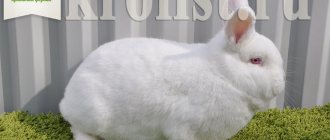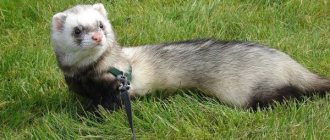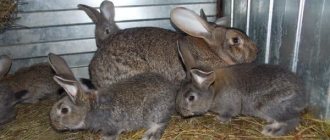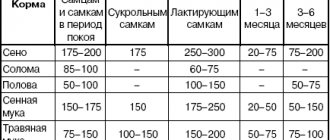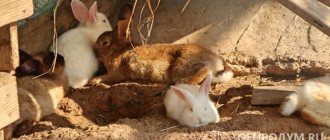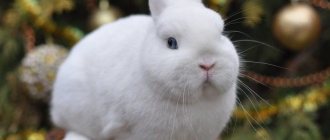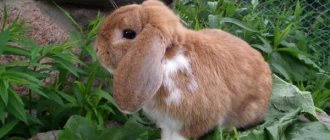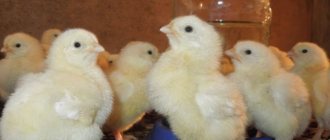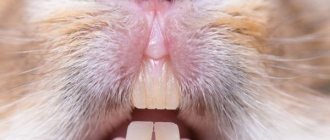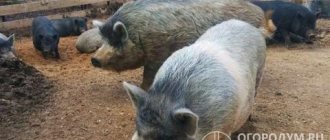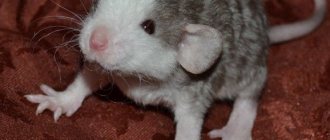- home
- Rabbits
- Breeds
01/11/2019 The red rabbit is found among representatives of several species. Coat color is one of the factors influencing the decision to purchase an animal. Regular owners choose the color they like. Breeders are concerned about the purity of the breed. Farmers are guided by the demand for certain skins. Before purchasing an animal, it is useful to find out what features each variety has.
Burgundy red rabbits
Burgundy redheads are the result of crossing several species. The main genes were inherited from Californian and New Zealand red individuals. The new species has become one of the best among meat animals - its representatives are distinguished by the developed muscles of the rear part of the body (lower back, sacrum, hind legs). Burgundians have a short, coarse coat that is light yellow-brown in color. Sometimes there are individuals with a black or pink nose. The ears are of medium length; when viewed from the side, their shape resembles a spoon. The body and head are elongated, the neck is short.
Burgundy rabbits have a strong immune system: they live up to 10 years if kept properly. These animals are prone to obesity and therefore require a balanced diet. The weight of an adult is 4.5 kg: baby rabbits reach it by 4–5 months.
general characteristics
Today there are 3 breeds, the main feature of which is the red color of their coat. They differ from each other in origin, size and position of the ears. This:
- Burgundy red rabbits;
- representatives of the New Zealand breed;
- red rabbit mini-ram (the main color of the breed is bright fiery).
Some veterinarians believe that red rabbits have a shorter life expectancy than any other breed, but this fact has not yet been scientifically confirmed.
New Zealand Reds
For the appearance of this species, Belgian Flanders and silver rabbits took part in the selection. The resulting New Zealand reds are hardy and unpretentious to temperature, thanks to which they are able to live in different climatic conditions. The breed began to be bred en masse only at the end of the 20th century, although it was formed much earlier.
The body of New Zealanders is cylindrical, the constitution is massive, the legs are short and thick, and the pads are heavily pubescent. Rounded head, short neck, ears stand straight and rounded at the ends. New Zealand Reds are a breed of red-colored rabbits: their color varies from pale red to red-brown. The fur of the animals is short and soft. Females are larger than males, their weight reaches 5 kg (for males - 4-4.5 kg).
Rules of maintenance and care
Animals need to be provided with comfortable and peaceful living conditions. The absence of high humidity and drafts is important for them. Housing should be warm and safe. Cleanliness is the main condition for animal health. Cages need to be cleaned regularly. Feeding on a schedule is also important because rabbits need frequent feeding.
Expert opinion
Zarechny Maxim Valerievich
Agronomist with 12 years of experience. Our best country expert.
Ask a Question
Animals are given balanced feed, always hard food (branches, grain, juicy root vegetables), and constant access to clean water.
If the rabbit will live in the house as a pet, it should have its own place away from open windows. Wires, valuables, and plants need to be removed from the apartment. The animal needs to be provided with water and food, limit contact with small children and create a calm environment, because rabbits are nervous creatures, and stress causes them to develop depression and illness.
Representatives of the sheep breed
Ram is a collective designation for lop-eared rabbits. This name was chosen because of the slight visual similarity of their heads (wide forehead, blunt nose) and drooping ears with those of a sheep. They are used in the meat industry, but are also common as pets.
The most common types of sheep:
- French: large animals, average weight – 4–8 kg.
- English: also massive, distinguished by excessively long ears - up to 70 cm.
- Corduroy: decorative, no more than 3 kg.
- Dutch: The smallest of the rams. The weight of an adult does not exceed 1.8 kg.
The red lop-eared rabbit of agricultural breeds is large in size, weighing 4–5 kg (some specimens reach 8 kg). Due to their size, it is difficult for them to choose a cage or enclosure of the appropriate size. There is no such problem with decorative varieties. The animals have a wide chest and a massive head. The wool is soft, of different colors: white, black, chinchilla, spotted.
Features of breeding for sale
Decorative rabbits give birth approximately 8 times a year, but this number may be less. Small breeds begin to reproduce at approximately 6-7 months.
The behavior of a female rabbit that is ready to breed changes dramatically - she rakes the litter into one place and begins to build a nest. For mating, the female is placed next to the rabbit (strictly - the opposite cannot be done).
It is recommended to leave her in the male’s cage for some more time for repeated matings, and then return her back to her house.
After giving birth, the baby rabbits are left with their mother
If the female is not ready to mate, she will thump her hind legs and simply behave aggressively. In this case, the animals are seated and wait for a more favorable moment.
After mating, a pregnant female, after a couple of weeks, when she joins the male, begins to behave unkindly and fights off. This is how they determine whether it is covered or not. The method is not 100%, since some pregnant females also like to mate.
You can carefully palpate the rabbit's body - small rabbits feel like balls. Under no circumstances put pressure on your stomach, especially not too much. Also, pregnant females often develop a voracious appetite. Birth occurs on average 31 days after covering. The baby rabbits are left in the cage with the mother - she feeds and licks them.
Rex
Rex was the result of a mutation of the Belgian giants, which gave birth to offspring with short hair. The name comes from the Latin word meaning "king". Rexes have short but thick plush fur. The body is elongated, the neck is strong. The head is elongated, with a wide forehead. The animals' ears are straight, stick up, and reach a length of 11–12 cm. The peculiarity of these animals is their short, curled mustache.
Thanks to thin bones, Rexes have low weight and high meat yield. The weight of an adult is 3–5 kg. Rexes can easily tolerate temperatures down to -30°C.
The disadvantages of Rex include:
- intolerance to high (from 25 degrees) temperature;
- slow growth and late maturation of cubs;
- low fertility (5–6 rabbits).
Purpose of decorative rabbits
The name itself contains the purpose of these cute animals. They are not raised for production needs - meat or fur - but are pets. Quite often, families with children get decorative rabbits, since it is impossible to pass by such a cutie in a pet store. In addition, they have a calm disposition, are not as active as cats and do not make as much noise as dogs. This type of rabbit differs from dwarf rabbits in that it does not have specific size standards.
Decorative species are characterized by different breeds, parameters and shades of wool.
Pygmy fox
Bred in Austria in 1992 using downy Angoras. Dwarf foxes are one of the smallest. Their weight does not exceed 1.5 kg. The breed is characterized by soft, thick hair that evenly covers the body on all sides. The length of the hairs is 3.5–7 cm. The body is small but strong, with a wide chest and shortened front legs. The neck is short and almost invisible, the ears are straight and stick up.
These red decorative rabbits have beautiful skin, but are unprofitable for industrial breeding due to low fertility and small body size. Dwarf foxes often participate in shows where white and havana are the recognized colors.
Diseases
Decorative rabbits can suffer from infectious and viral diseases. The main ones are rhinitis, stomatitis, staphylococcosis, otitis, conjunctivitis. The animals suffer from intestinal disorders, and the active growth of teeth causes them severe inconvenience. A complete list of diseases of decorative rabbits is presented in this material.
It is recommended that decorative rabbits receive vaccinations - and, believe me, they will cost you much less than further treatment.
Competent care and proper feeding will help to avoid diseases. Make sure that the animal’s diet is balanced, otherwise constant diarrhea cannot be avoided.
Stomach upset is caused by weevil-infected dry food, excess fruits and vegetables, moldy bread, sudden changes in feed, gastrointestinal diseases, unsanitary conditions, and viruses. A common occurrence is constipation. Read what to do if your rabbit is constipated here.
In case of diarrhea, you need to disinfect the cage and give the animal a decoction of chamomile. If it doesn't go away for a long time, contact your veterinarian.
It is necessary to monitor the health of rabbits by regularly conducting veterinary examinations.
Angora saffron milk caps
Angora is the name given to all rabbits whose distinctive feature is long fluffy fur, which easily distinguishes them from other varieties. The skin consists of 90% fluff, which makes the wool soft and silky. Among Angoras there are dwarf, medium and giant species. Small red individuals, depending on the variety, do not exceed 2 kg in weight, while agricultural ones reach 6 kg. Common breeds include: English Angora, French, German, Satin. Average life expectancy is 4–5 years.
The skin of animals requires constant care: regular combing and keeping clean. In some individuals, fur grows abundantly above the eyes. In such cases, it is trimmed so that the animal does not have vision problems.
Tips for choosing
Regardless of color, rabbits are selected according to the same criteria:
- The animal must be strong and healthy, not show signs of disease, and not refuse food and water.
- If a purebred rabbit is purchased, it must have documents issued by a responsible breeder.
- It is worth purchasing pets from trusted people who professionally breed rabbits.
- A domestic rabbit should have a good character, a calm disposition, and no aggression. This is important if there is a small child or other pets in the house.
- You should not take large breed rabbits into a small apartment.
Compliance with the rules will help you purchase a healthy and cheerful rabbit, which will become a pet or bring strong offspring - a source of income.
Homemade
Representatives of domestic breeds of rabbits can be kept both outdoors (for meat and fur) and at home - in a special cage. Animals can freeze outside in cool weather.
The home cage is lined with sawdust or straw, which is changed regularly.
Animals are not allowed to walk around the apartment! It happily chews furniture upholstery, wires and other interior items. Rabbits of these breeds can be trained to defecate in a tray with a special filler.
Butterfly
This English breed was originally considered a decorative breed. Later representatives of the breed were crossed with Flanders and Viennese Blues. Hybrids are grown for their skins.
Adults have a compact body with a small head and short erect ears. Body length 56-58 centimeters. The chest and back are wide. The limbs are long.
The skeleton is strong with well-developed muscles. The fur is short and thick. The main color of the skin is white. A characteristic feature is the presence of black-brown spots. The nose, ears and scruff are black.
There is a dark stripe in the center of the back. Weight up to 4.5 kilograms or more. The female is fertile, bringing up to 8 babies in one litter.
Vienna blue
The result of crossing the Flanders and Moravian Blue breeds. This hybrid can be classified as an endangered species.
The body is folded proportionally. The head is neat with straight ears rounded at the ends. The back is wide. The body is medium in size with a rounded croup.
Limbs are straight and strong. The fur is thick, uniformly colored bluish-blue. The inner surface of the ears is light. Average weight 4.5 kilograms. The female gives birth to up to 9 babies in one litter. The breed is valued for its high fluff content - the skin is extremely delicate and soft.
Squirrel
In 1916, German specialists bred rabbits with extremely decorative, high-quality fur. It is thanks to its originality and quality that the breed acquired its name - Belka, due to its similarity with Aleutian squirrels. These animals were bred through repeated crossings of Havanna and Blue Vienna breeds.
Rabbits of this breed are bred mainly for their fur, although the breed is considered a meat-skin breed, the skins are of high quality, unusually colored and are widely in demand in the fur industry. The breed is poorly represented in our country and is mainly bred in Germany.
Among the advantages of this breed, the main ones are low demands on feed and fairly simple conditions of keeping and rearing. Rabbits of this breed adapt well to various weather conditions, they can even be kept outdoors, they are quite hardy and resistant to diseases of the species.
Tortoiseshells
The history of selection of tortoiseshell rabbits is unknown; they are very rare and, unfortunately, only among those who like to breed rare breeds of rabbits. The rabbit breeders who developed this breed were obviously aimed at obtaining beautiful skins, and only then for meat.
The tortoiseshell rabbit is of medium size, quite strong in constitution, and its body composition is expressed in correct proportions. It got its name because of the peculiar original color of its fur.
The color is yellow-reddish, but with a slightly pronounced reddish tint, reminiscent of the skin of a fox at the height of summer. An adult tortoiseshell rabbit gains weight up to 4.5 kilograms.
Mothers from tortoiseshell rabbits turn out wonderful, they are quite balanced and give a large amount of milk, the rabbits grow quickly and you don’t have to worry about their safety.
Keeping a tortoiseshell rabbit is not particularly difficult, since they are unpretentious and can easily tolerate even harsh climatic conditions when kept in outdoor cages.
High quality fur products are made from the skins of tortoiseshell rabbits and have an excellent natural appearance. All this has greatly raised the price bar for the fur of these animals.
Features of the view
Decorative rabbits were bred for indoor use. It is best to buy them in nurseries or from trusted breeders - stores rarely follow the rules for caring for the animal and do not give any guarantees that you will buy a healthy animal.
On sale you can find different types of decorative rabbits - with erect ears, ram rabbits, with red eyes, and so on. The most beautiful breeds are those with long hair, but keep in mind that they require careful care (the fur is combed daily).
Ornamental rabbits can also be raised for meat and fur. In this case, fairly large specimens are used.
The life expectancy and health of your pet largely depends on you, or rather on how carefully you comply with the conditions of its maintenance. In general, a decorative rabbit is a breed for the soul; such an animal will become a true friend for the whole family.
How to determine the breed?
There are quite a few varieties of decorative rabbits. Often a pet is chosen without knowing the breed, but only according to external data. But ultimately the question arises about the type of decorative rabbit.
To find out what breed the selected animal belongs to, you need to pay attention to several parameters:
ears - shape and size;
Short-haired rabbits have a dense build, short legs and the same neck. Dutch have prominent rings around the eyes, the back of the body and head with ears are dark in color. Angora varieties are characterized by long hair, the fur can be either shiny or fluffy, similar to cotton wool. Angora lions have long hair all over the body except the muzzle. The lion's head resembles a miniature king of beasts.
Dwarf foxes have long hair, but it is quite tough. Folds are distinguished by the shape of their ears: they are long and drooping. The dwarf butterfly is distinguished by its characteristic color on its face. Completely white small rabbits with a large head and red or blue eyes are hermelines, and the presence of dark spots on a snow-white coat indicates a miniature hare. The short, plush fur belongs to the Rex breed.
If the fur does not stand out in anything special, you should pay close attention to parts of the body: ears, head, paws. Colored dwarf rabbits have small ears and compact bodies. Their fur comes in different colors. It is often very difficult to determine the breed of small rabbits; they may not meet any criteria. In this case, you need to wait a little.
The size of the body, especially the ears and head, changes noticeably as they grow older. If the animal's erect ears begin to tilt and become longer, most likely the pet belongs to the fold-eared family.
If you want to breed animals of a specific breed, it is better to take them from knowledgeable breeders or in special nurseries. This way you will be guaranteed that you have purchased an animal of the required variety.
